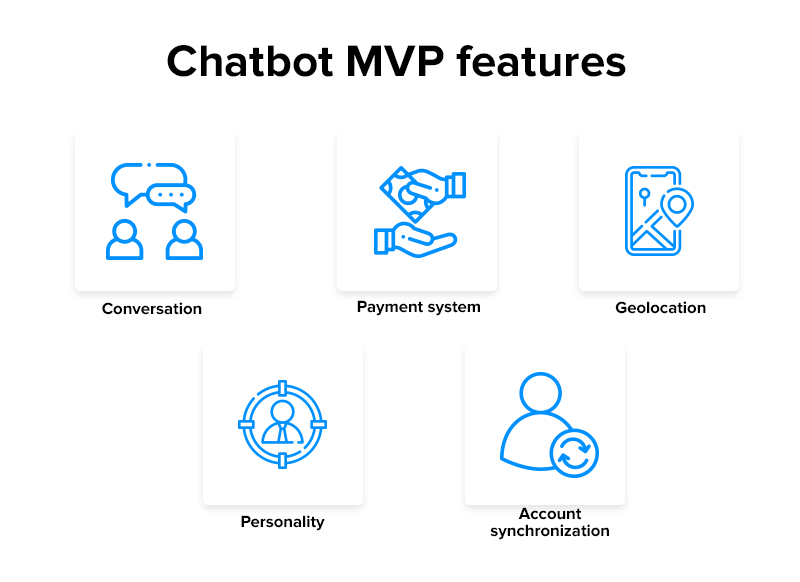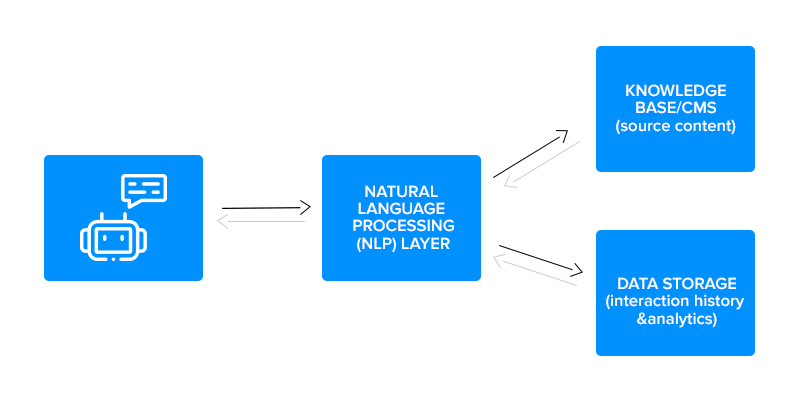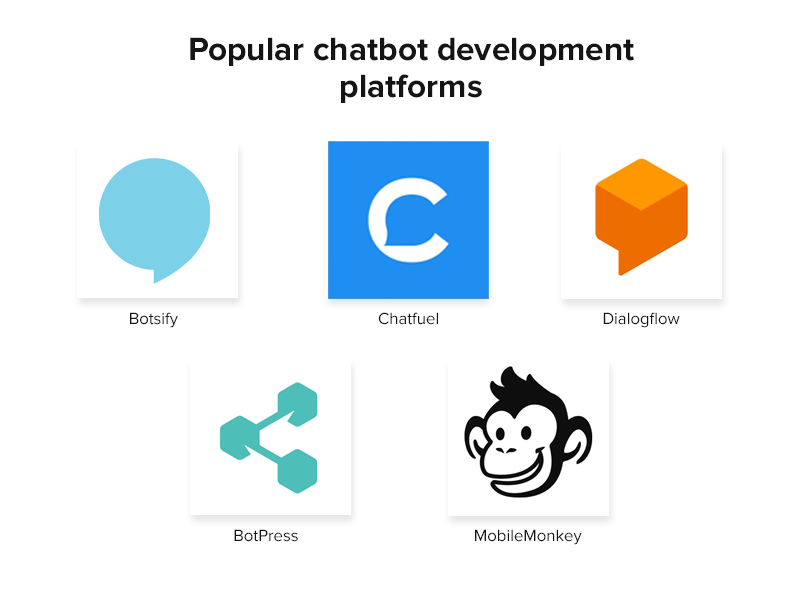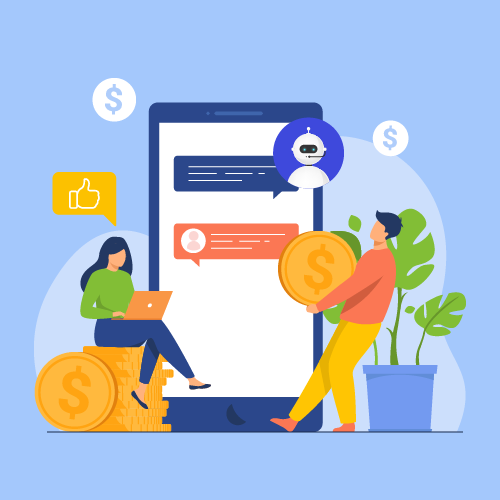How Much Does it Cost to Develop A Chatbot?
The modern-day business world has found a number of uses for chatbots. From increasing the user engagement count to play a major part in the lead conversion process, chatbots have entered the world across industries.
The fact that chatbots are equally famous among baby boomers and millennials, increases the user base of the technology to a great extent.
Observing the business benefits and the flourishing market size, there are a number of businesses that are looking forward to building chatbots using deep NLP and launching it for their own app and for others to use.
In this article, we will be looking at how much it costs to build a chatbot and everything surrounding the transformative technology.
But before we get into cost benefit analysis of chatbot part, let us first look into what the flourishing chatbot market looks like.
Chatbot Market
Within the past one decade, chatbots have witnessed an unprecedented demand from a number of industries around the globe, including logistics and on-demand. What was earlier restricted to only eCommerce has now shifted to a number of other domains ever since the advent of mobile apps. All this has been the doing of growing inclusion of growing level AI in customer experience.
{Also read our descriptive guide on ‘Logistics App Development Cost’}
By the time we reach 2024, the market size of Chatbots would have increased to $1.34 Billion – a number that is driven by the inception of disruptive technologies like Machine Learning and Artificial Intelligence in the chatbot mechanism.
From the simplistic rules specific chatbots developed to manage uncomplicated queries to cloud-based self-learning bots that are designed to understand the user intent and automatically modify the output, chatbots, no matter how learned or simple are being used extensively in fields like eCommerce, Healthcare, etc. via business data integration.
The fact that chatbots have proved themselves to be this useful in the world, has prepared them to contribute $1250 million by 2025.
Seeing the market share that chatbots hold, one thing is clear – Chatbots are going to be a very prominent part of businesses across industries. And why not, after all, the business benefits that they have to offer are unmatched and unparalleled.
Talking of business benefits of Chatbots, let us look at what they are before we move on to the chatbot development cost.
Business Benefits of Chatbots
It is invalid to ask the question ‘How much does it cost to build a chatbot’ until you are convinced that they are needed.
Besides the obvious benefit of making your business a 24*7 business, Chatbots, no matter how much you pay in the name of chatbot development life cycle, come with a number of advantages that are known to lower the cost of business operation, which tend to unnecessarily tend to close the gap between gain and loss numbers in the balance sheet. All aimed at changing your business growth story.
Here’s what they are:
A report by Juniper Research validates that the cost of building a chatbot is going to be a much smaller amount in front of the costs that chatbots are all set to cut down – $8 Billion on a yearly basis – by the time we reach 2022.
Let’s see how:-
Lowered operational cost
The biggest operational cost in businesses is around the number of incoming calls. By giving the visitors answers to what they are looking for, chatbots are able to save on the cost associated with the increasing call volumes and in fact the whole interaction volume.
In addition to this, when users call businesses after having the preliminary level of interaction with a chatbot, the time of customer care executive that would go behind answering the first level interaction gets lowered to a huge extent.
Cut down labor expense
In a report, McKinsey estimated that around 29% of customer service position in the US can get automated via a properly designed chatbot. The fact that chatbots can interact with multiple people at the same time, hints at a time where the customer engagement industry would be dominated by chatbots.
In addition to this, businesses who have employed chatbot in their customer service program know how chatbot implementation costs much lower than the annual salary of an employee while doing twice their work.
Cost effective 24*7 availability
The modern-day customers expect businesses to be available 24*7 to answer their queries at all hours. The fact that a number of businesses are still not able to function on a 24*7 mode has not just made them lose on to prospective sales but also has affected customer loyalty to a great extent.
But when you employ a chatbot that has been designed to answer to the customer requirement in the off hours when your customer rep is not available, you make them more receptive towards your business, altering your brand image 180 degrees.
Better resource allocation
When the customer representative doesn’t have a list of customers to attend to and knows that even in their absence their customers will be handled with equal attentiveness through a chatbot, they are able to concentrate on devising strategies on keeping the users hooked and finding ways to help chatbot close more leads.
This way, chatbots prevent sales reps from falling into the cycle of mundane work and monotonous job cycle, giving them the opportunity to keep learning.
Greater revenue
There are a number of businesses that have been using Chatbots for lead conversion and greater sales. Through chatbots, you can keep alerting your customers of the discount opportunities and increase the engagement and upsell count.
Along with making a business a sales conversion magnet, chatbots help create a strong brand awareness when integrated with social media messenger platforms.
Increased customer engagement
It’s vital to keep your clients involved with your brand. As indicated by companies, organizations that involve with their customers through social media were able to increase the user spend by 20% to 40%. While social media is doing its work, chatbots can contribute by making customer engagement interactive and easy.
Monitoring consumer data & gaining insights
As you already know that chatbots are great devices and tools to chat with customers. With the input they gather through basic inquiries, you can make improvements on your administrations/products and even upgrade your website by adjusting low converting pages. For instance, if your landing page creates a decent measure of organic traffic but doesn’t convert well, your chatbot can contact customers visiting the page with a study to gather more data on why they are leaving the page without buying or making action and so forth.
The chatbot benefits are equal among all the different types of bots. No matter what type your chatbot gets categorized the benefits mentioned above will hold true for them all.
Speaking of types, let us look at the different Chatbot types that are most commonly employed by businesses across the world.
Type of chatbots
When we look into the types of chatbots, we have to look at both – the Superset and the Subset wise demarcation of Chatbot development type, having elements that goes into interactive chatbot development.
The supersets
There are two categories of chatbots that you can invest in.
- Bots Implemented in Own App – These chatbots work inside a mobile app which performs a specific function for the sake of automating the interaction happening between the app and the user.
- Bots which Function Within Messenger – These chatbots stay in messengers which support bot interaction. These work best for businesses that do not have a standalone app or wish to keep social media at the center of the business model.
The Subsets
Within the prime categories of the chatbot mentioned above, there are a number of chatbot types that you can get made –
- FAQ chatbot – A basic QnA or FAQ Bot provides its users with automated responses to frequently asked questions in a natural, intuitive question-and-answer conversational style.
- Conversational chatbot – The chatbot type uses language understanding services to have easy flowing conversations with the end users. They are usually made to A. collect the basic information about the users and B. keep them engaged till a human customer care executive is online.
- Transactional chatbot – These are the chatbots that help the app users to inquire into and buy something off the app without ever talking to a human customer care representative.
- Predictive Chatbot – These chatbots are the most advanced ones in the market at this time. They are developed and designed on a case by case scenario. By incorporating heavy machine learning in them, businesses use predictive chatbots to analyze how users might react next.
Irrespective of what type your chatbot belongs to, the elements that go into it are all the same. Something we will be attending to, next.
MVP Chatbot Features

Conversation
Conversation, one of the primary needs and features of chatbot should be based on a fundamental principle. In the basic principle, the request for messages ought to be logical and comprehensive for each customer. For example, when a customer asks about the contact number of your organization, the chatbot should tell the user just a number. If it informs about the address, it implies that the entire rationale is broken.
What’s more is that, ensure that your chatbot doesn’t commit grammatical errors and follows the overall pace of the discussion. Keep an official discussion tone in case you’re focusing on business people. If the task is somewhat hard for you, it’s smarter to hire a freelancer to produce content for the messages.
Payment system
This feature suits e-commerce chatbots. If your bot’s main goal is to boost sales and create new distribution channels, you should take care of at least one payment method. This is the point for you to choose between the third-party system or a custom payment solution.
A well-designed payment system eases the flow of the payment security and allows to analyze the payment and customer behavior. What’s more is that you don’t need to stress over expenses that are generally charged by third-party systems. Regardless of advantages, the expense of a custom payment framework is excessively high. That is the reason why most of the small organizations execute services such as PayPal, Braintree, Stripe, and others.
Geolocation
Online mapping is another helpful feature for a chatbot to attract new customers by pinpointing the area of your business on the map. For instance, users can request the bot to help them navigate to the restaurant or street they’ve never been to. Google Maps Platform permits you to make this feature with zero effort. All things considered, it draws customers to visit your place.
If we take an example of food delivery, then this feature is the best. All that your users need to do is to place an order using the chatbot, make payment through an integrated payment gateway, share the location with the delivery personnel, and enjoy the food after arrival.
Personal touch
The personal touch is more about the personality and character than the technologies. Mentioning users by their name rather than pronouns, elevates their feelings and emotions. The personal mentality to every customer ensures increased brand loyalty and positive input about your chatbot.
To make a remarkable and unique chatbot, you can utilize the knowledge of a brand expert. In case you’re on a tight budget, you can always bring into play your imagination and creativity.
Account synchronization
The first use case of account synchronization that rings a bell is redeeming rewards. If there is a promo system, then the users have some awards or bonuses from the past purchases, which users can spend during further purchase. Nonetheless, if the chatbot isn’t synchronized with the website, it doesn’t display the rewards. Thus, you need to ensure that your platforms have a typical database that continually shares data with one another.
A synchronized record permits you to carry out efficient marketing campaigns. Whenever there’s a discount or sale on a product from the customer’s wish list, the chatbot sends a warning about it. This methodology is more successful than promotional e-mails and messages.
The Composition Required to Build a Chatbot
There are a number of components and chatbot design strategies that come together to develop a chatbot that goes on to revolutionize the customer experience that a business offers, all coming as an addition in the breakdown of chatbot pricing models.
Before acquiring the knowledge of building a chatbot, let’s have a look at the image that describes the working of it.

As a business who is looking to partner with an agency that excels in chatbot development services, you should look at their approach in the context of all these components before making any decision.
Backend
Chatbots need a backend to manage messages coming in from different channels and to process them with NLP offerings like Api.ai, LUIS, or Wit.ai. The backend also holds business logic and integration within the current systems and is used to develop conversational intelligence on the basis of which conversation happens with the end users.
Channels
After your backend is set up, you will have to create the endpoints for the integration with every specific channel. While every single channel integration is different, they mostly follow the same method of endpoint set up in the backend for the purpose of sending and getting messages which rely on the access token authorization. Also, you will have to implement the channel-specific user interface in places like quick reply, visual cards which guide users during a conversation.
NLP
The moment you receive messages from a specific channel, you are going to use NLP services like Luis, Api.ai, and Wit.ai for extracting the entities and intents out of the user message. While the set up of NLP service and processing of messages with the help of SDK is pretty direct, training the NLP entities and entities which might be present in an external system is not an easy task. You will have to understand the entities which map to specific objects which exist in systems like Contacts, Products, or Employees.You will also have to implement business logic validation on the extracted data which can range from simple validation to custom.
Conversational intelligence
This is the most complicated component of the whole chatbot development process. You will have to design intelligent conversations on the basis of NLP entities and intents – something that is not easy.To achieve a stage where you build an intelligent chatbot, you will have to create an algorithm for every single conversation and navigation so that users can start from scratch. You will have to make use of decision trees, slot based algos, state workflows, or other deep learning methodologies for controlling the conversation.
Integration
Because of prime purpose of your chatbot is the execution of processes like booking appointments, buying products, ordering items, etc. you will have to integrate the chatbot in an existing mobile application. Integration here will involve factors like business logic rules and validations, the persistence of data which would be required as a part of the business process.
Now that we have looked at the different components that come together to make a chatbot, it is time to attend to the things that matter to you on a more intricate level – the time it would take to develop a chatbot and the cost of chatbot development, in accordance with the different metrics that chatbots are evaluated on.
The time it takes to develop a Chatbot from scratch
A very important part of the whole chatbot app development process for businesses and an answer to the cost of chatbot development is knowing how much time it is going to take for chatbot app development company to develop them so that they get a rough idea of when to start witnessing unprecedented customer satisfaction graphs.
Well, here’s an answer to the hours it would take to develop a bot, something that will have a direct impact on your chatbot cost –
Integration with an app – the duration of it depends on the chatbot complexity, but usually it takes up 40-56 hours. Development of communication interface
- Command language user interpreter takes up somewhere around 40-56 hours.
- Natural language user interface takes somewhere around 120-160 hours.
Business logic
- Adaptation of an existing business logic, takes up 120-160 hours, depending on the amount of logic.
- Development of business logic from scratch takes around 160-192 hours.
Since you now know the approximate hours it would take to attend to different parts of chatbot development, it is time to translate those hours into the cost of chatbot development.
Decreasing the Chatbot development Cost
There are a number of aspects that increase the price of chatbot development. But there are also the option to stabilize the financial impact like the chatbot development tools that save time for developers and decrease the eventual final cost.
Third-party platforms
Developing a chatbot from the scratch without any preparation is quite expensive. Thus, to solve this people generally use third party platforms. With the assistance of these popular platforms, you can make a chatbot with less efforts and time.

Despite the fact that these platforms guarantee rapid development, they also provide flexibility and adaptability which lets the developer use them often.
Some of the common and popular chatbot platforms are:
Chatfuel
Botsify
Dialogflow
BotPress
Mobile Monkey
How Much Does It Cost To Develop a Chatbot? – The Exact Chatbot Development Cost
Now that we have seen all – The market of chatbots, benefits that they have to offer, types of chatbots that are presently ruling the world, and the components that come together to develop them along with the time it takes to develop chatbots, it is now time to look at how much it is going to cost you.
Seeing the work that goes into developing a chatbot, the approximate chatbot cost that comes for development of your bot is in the range of $25,000 to $30,000.The cost range includes the design, development, and integration part of the whole chatbot development framework.
With this, we have now seen all – the benefits of chatbots, features and components that helps to devise a well-structured chatbot, the market size, the type and the cost you will have to pay to get your chatbot developed, the only thing left for you to do here is to get in touch with our chatbot developers and avail the best chatbot app development company in USA.

strategies your digital product..



